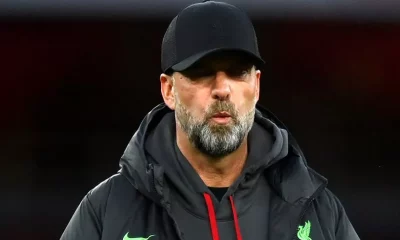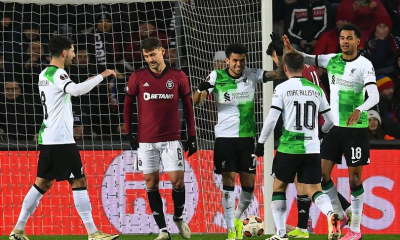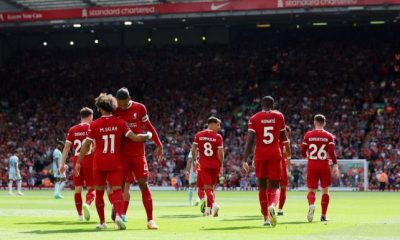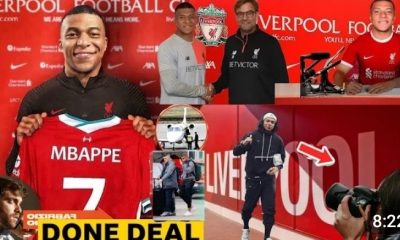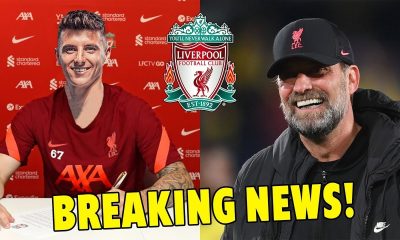Liverpool
Man City star, Fulham ace: 8 midfielders Liverpool could sign as Caicedo & Lavia alternatives
Man City star, Fulham ace: 8 midfielders Liverpool could sign as Caicedo & Lavia alternatives
Liverpool are starting to get desperate in their search for a Fabinho replacement.
Highlights
Liverpool’s pursuit of defensive midfielders Moises Caicedo and Romeo Lavia has failed, forcing them to look for alternative options before the transfer window closes.
We’ve identified eight potential candidates to fill the void left by Fabinho.
Each player offers unique qualities and would provide Liverpool with the defensive midfield presence they need, but price and availability may be factors to consider.
Liverpool have two weeks left to find an alternative defensive midfielder to sign following their failed pursuits of both Moises Caicedo and Romeo Lavia.
The club had inexplicably agreed a £111 million deal with Brighton for Caicedo to move to Anfield late last week, before being informed by the Ecuadorian that he preferred a move to Chelsea instead.
Once that deal was off the cards, it was expected that Lavia would become the obvious candidate to fill the Fabinho-shaped role after the Brazilian moved to Al Ittihad earlier in the transfer window.
However, after moving for Caicedo in such a big way, it appears the Saints’ midfielder became unsure on joining Jurgen Klopp’s side, and he is also set to join Chelsea, who are becoming an increasingly big thorn in the reds’ side.
Further to that point, the two clubs met in the opening weekend of the Premier League at Stamford Bridge with the spoils being shared in the end. An open game showed exactly why both teams are in desperate need of reinforcements when it comes to defensively-minded midfield players.
Chelsea have got their main target in Caicedo as well as a very talented back-up option in Lavia lined up to come in. Liverpool are now going to have to head back to the drawing board and re-assess the midfield market in order to act fast and get in at least one player.
Who could Klopp and his team of scouts turn to in order to solve their midfield dilemma?
Kalvin Phillips
It has been a difficult 12 months at Manchester City for the English holding midfielder, with only 17 appearances in all competitions during his debut campaign. It is a massive disappointment when considering how impressive he was as part of Marcelo Bielsa’s Leeds United team that got back into the Premier League for the first time in a decade.
A very able tackler is what Liverpool need, and Phillips is better in possession of the ball than he often gets credit for with a strong passing range and a cool head under pressure. It is a very unlikely move with the fee City would demand from a club they see as a rival, and his lack of game time does not help his case either.
Joao Palhinha
After a brilliant first season in England, many have been left shocked at the fact Fulham were given a seemingly free run at his signature the previous summer. Although he is 28 years old and not quite in the age range Klopp tends to shop in, he is perhaps the closest player to Fabinho that the Reds could hope for.
Not the most extravagant performer in terms of his on-the-ball skill set – but a sensational ball winner – he could be exactly what the club needs. With Alexis Mac Allister and Dominik Szoboszlai already added to the ranks in midfield, all that is needed is a player to do the dirty work and win the ball back to then play to the more creative players.
However, his price tag is expected to be huge, and he is currently ruled out by injury.
Andre
There have been rumours circulating in the world of social media that Liverpool are keeping a keen eye on Andre of Fluminese. The Brazilian is the least known name on this list, but it could represent a welcome change in strategy going forwards. Instead of going for players that have moved to the Premier League for minimal fees and impressed – such as Caicedo – for massive fees, the club could cut out the middle man.
The South American market consistently churns out top talent and Andre could be one of the next names in a long list of players from Brazil to make it in Europe. There are complications in the deal as his team are not keen on the idea of letting him leave before the end of the year, so it could be one to keep an eye on for the winter transfer window.
Martin Zubimendi
Soccer Football – La Liga Santander – Real Madrid v Real Sociedad – Estadio Alfredo Di Stefano, Madrid, Spain – March 1, 2021 Real Sociedad’s Martin Zubimendi in action with Real Madrid’s Mariano Diaz REUTERS/Sergio Perez
This is an interesting alternative to a traditional Klopp defensive midfielder. Zubimendi would have Liverpool fans fondly thinking back to the years of Xabi Alonso controlling games from the middle of the park, and making it look easy in the process. Alonso has even had a hand in the Real Sociedad man’s development in the game during his time with the club’s reserve set-up.
Xavi appears to have been keen on bringing the 24-year-old to the Nou Camp to replace Sergio Busquets, who recently moved to Inter Miami in the MLS. If the aim is to control possession more, he could be the best option of the lot, while he is also capable of getting stuck in and winning duels in his own right.
Manu Kone
Links were persistent at the beginning of the transfer window with the French midfielder, but an injury sustained at the Under-21 European Championships put an end to that speculation. Kone has not always been deployed as a defensive midfielder at Borussia Mönchengladbach, with sporadic shifts as a box-to-box midfielder.
He has all the skills and ability required to be made into an out-and-out destroyer in the engine room, as he is full of energy and tenacity while more than capable of linking up play well. The fee would not be in the same outrageous bracket as others on this list, meaning he could be a good shout if two players are brought in.
Ibrahim Sangaré
PSV have no doubt been waiting on offers for the Ivorian for a couple of transfer windows now as his name has grown over time. At 25-years-old, Sangaré is at an ideal age to be brought in to be a regular starter straight away, which is what Liverpool needs realistically.
He does not have experience in the league already as some of the previous options have, but with better players around him, there is a good chance his game will be elevated. A lack of Premier League experience can also be a positive in the sense that the transfer fee won’t be at an absolute premium.
Youssouf Fofana
Having featured at the 2022 World Cup for finalists France, Fofana is experienced on the big stage, which could come in handy if moving to a club like Liverpool. Adept at winning the ball back quickly and playing the ball off to more advanced players, he could also be a good fit for the club.
He is good in the air, like Fabinho, meaning he would allow other midfielders the freedom to remain higher up the pitch. A French international is likely to command a decent fee, but nothing on the same level as Lavia or Caicedo.
Cheick Doucoure
Crystal Palace’s player of the season in 2022/23 is as close a comparison to Caicedo as the club are likely to find. His time playing in France demonstrates that he has an eye for a progressive pass and is not just a ball-winner. With that being said, he is very difficult for opponents to pass, unlike players utilised in the role for Liverpool recently.
Likely to be the most expensive name on the list, particularly with Palace unlikely to want to lose a key man after the start of the season, it will take close to £80 million to make this move happen. With plenty of money being available to bid for Caicedo, it is yet to be seen if the club would value Doucoure at this price.
READ MORE…..
Liverpool must now pay £32m to sign ‘dynamic’ Lavia alternative – journalist
Liverpool will have to trigger Ibrahim Sangare’s release clause if they want to sign the PSV Eindhoven midfielder this summer.
That is according to Eindhovens Dagblad journalist Rik Elfrink.
In a Twitter post, Elfrink stated that PSV’s position is that anyone who is interested in Ibrahim Sangare has to activate his release clause, which is set at around £32m.
The journalist initially reported that Liverpool have the Ivorian on their radar as they look for an alternative to Romeo Lavia.
The Reds are set to miss out on the 19-year-old, with The Athletic claiming that he has chosen to join Chelsea instead or Jurgen Klopp’s side.
What would Ibrahim Sangare bring to Liverpool?
Former PSV director of football John de Jong has described Sangare as a “dynamic” and “physically strong” midfielder. Ultimately, he is the profile of player Klopp probably needs for his engine room right now.
The German recently lost Fabinho, while a whole host of other midfielders have also left Anfield this summer, so there is clearly a lot of work to do in that area of the pitch.
Liverpool supporters will be disappointed with missing out on Lavia and Moises Caicedo. With that in mind, turning to an alternative in the Eredivisie may feel a bit underwhelming, but Klopp is starting to run out of options as the transfer deadline draws closer.
Photo by Photo Prestige/Soccrates/Getty Images
Again, the Merseyside club have watched so many players in the engine room depart during this window, so they have to sign someone.
The above does not necessarily mean that Sangare is the answer to all of Liverpool’s midfield problems, but he certainly seems to have the skill set to help Klopp’s side out.
The Reds’ goal will be to qualify for the Champions League this season, but that is probably not going to happen if they do not improve in the middle of the park.
MORE: Top 10 Saudi Pro League Players, RankedRelated Topics
espn.co.uk
Liverpool failed to sign Caicedo or Lavia, but here’s why they may not need a defensive midfielder
Ryan O’Hanlon, ESPN.com writerAug 15, 2023, 03:14 PM
Liverpool need a defensive midfielder, and everybody knows it. You know it. I know it. They know it. Chelsea know it. Brighton know it. Southampton know it. Jurgen Klopp said it, too.
“It’s not surprising we are looking for that position,” he said. “It’s clear and would be great if we could do something, but for now we can do a lot of things. … We can adapt the system and have options. But yeah, it would be absolutely great if we could [sign one].”
And this was before Sunday, when Liverpool drew 1-1 with Chelsea, looked brilliant for the first 30 minutes, and then smashed headfirst into the uncomfortable fact that you can have the most talented attacking team in the world, but none of that matters if you can’t get the ball and can’t keep the ball. They left Stamford Bridge with 35% of the possession — a lower figure than they recorded in any game last season against a team not named Manchester City.
They agreed to what would have been a record fee for Brighton’s Moisés Caicedo, only for the player to opt for Chelsea. Then they dragged their feet in the negotiations for Romeo Lavia, only for him to also reportedly opt for Chelsea.
There are two weeks left in the transfer window, and Liverpool do not have a true holding midfielder on their roster. What can they do?
Well, here’s an idea: What if they just completely ignored the position all together?
First, a word about Bill Belichick
This isn’t a vacuum. Across all sports, there’s a market for players, and the tactical approaches of the day combined with the distribution of available talent creates varying levels of demand for different kinds of players. Outside of maybe the handful of teams funded by sovereign wealth funds in soccer, sports teams can’t really just decide on the optimal way to play, and then just acquire the best players for all of the individual roles that would create that playing style.
No, the best way to play is whatever way gets the most out of the players who are realistically available to you given the league’s financial constraints.
play
1:24
Did Chelsea’s or Liverpool’s midfield need Caicedo more?
Steve Nicol explains who would benefit most from signing Moises Caicedo after Chelsea and Liverpool draw 1-1.
For most of his tenure as New England Patriots head coach, Bill Belichick knew this better than anyone. When he took over that team in 2000, most of the NFL was playing the 4-3 defense, which featured four defensive linemen and three linebackers. The linemen required the high-end speed to get to the quarterback when the opponent tried to pass, while the linebackers needed to be big and rangy in order to make tackles whenever the ball advanced past the line.
Instead of copying this and banking on his team’s ability to better identify and/or develop talent, Belichick instead opted to play a 3-4 defense. In this setup, the three linemen mostly needed to be large and plug gaps in the line, rather than rush the quarterback, while the outside linebackers tended to specialize in rushing the QB and didn’t need to be as beefy as the run-stoppers in the 4-3.
So while the rest of the league was devaluing smaller linebackers and bigger linemen, the Patriots were doing the exact opposite. There were suddenly all of these players who everyone ignored, but New England wanted. “So, if you wanted a nose tackle, there were plenty of them out there,” Belichick told the Wall Street Journal in 2015. “If you wanted a 3-4 outside linebacker, there were plenty of them out there.”
Under the 3-4, the Patriots won three Super Bowls from 2002 to 2004 — and then the rest of the league copied them. Within five years of his start in New England, Belichick claimed that more than half of the league had begun playing a 3-4 in response to the Patriots’ success.
Remember all of those easy-to-acquire pieces? Now everyone wanted one.
“You go to the draft board and think, ‘Here’s a nose tackle. Who needs a nose tackle?'” said Belichick. “Well, eight teams in front of you need a nose tackle, and there’s two nose tackles.”
– Stream on ESPN+: LaLiga, Bundesliga, more (U.S.)
In response, the Patriots pivoted again. “We’ve had to find different ways to capitalize on the talent that’s available,” Belichick said. “Otherwise, we’re going to get like the fifth-, sixth-, seventh-best guy at whatever the position is. So we’ve tried to take more of our way in areas that are less populated.”
Sounds familiar, huh?
So, back to Liverpool’s issueplay
1:36
‘I would choose Liverpool’: Burley comments on Caicedo saga
Craig Burley explains why he would choose Liverpool over Chelsea if he were in Moisés Caicedo’s position.
The situation at Anfield isn’t quite identical to Belichick’s, but it’s similar.
Back around 2010, in an era when the patient possession play of Barcelona had begun to influence the rest of Europe, Klopp’s high-pressing style — win the ball high, play it vertically, win it again, and on and on — created a dual competitive advantage. Not only did it work well on the field against possession-based sides — breaking play up and attacking the defensive gaps created by causing the turnover — but it also valued more physical, direct and aggressive players who maybe didn’t quite fit the precise, technical prototype that was all the rage across the continent.
Fast-forward to today, and all of the top teams across the world are trying to do different versions of the same thing: they want to press high, and they want to keep the ball as far away from their own goal for as much of the game as possible. The further you turn that dial — how much you want to press and how much you want to control the field — the higher the degree of stress you put on your holding midfielder.
That player needs to be the one to clean things up if the first line of the press gets broken, and he also needs to be proficient on the ball to help circulate play in the attacking third and also to move it up there in the first place. In a sense, the requirement is now that you have both elite technical skill and elite athleticism. Rarely do prospects who have both or even one of those traits get developed into defensive midfielders — they become attackers or center-backs — so there just don’t seem to be that many players in the world who are capable of competently playing the holding-midfield position at the highest level.
At least, that’s what the big clubs seem to think.
Heading into last summer, the most expensive defensive midfielder ever, per Transfermarkt’s positional designations and listed fees, was Rodri, who moved from Atletico Madrid to Manchester City for €70 million all the way back in 2019. Since then, five players have moved for more than €70 million:
Caicedo: Brighton to Chelsea, €133 million
Enzo Fernández: Benfica to Chelsea, €121 million
Declan Rice: West Ham to Arsenal, €116.6 million
Aurelien Tchouameni: Monaco to Real Madrid, €80 million
Casemiro: Real Madrid to Manchester United, €70.7 million
Right after Rodri on the list are two more players who moved this summer: Sandro Tonali (AC Milan to Newcastle, €64 million) and Manuel Ugarte (Sporting Lisbon to PSG, €60 million). And if Chelsea’s reported move for Southampton teenager Lavia goes through, he’d slot in right behind those two in terms of fees. In other words, eight of the nine most expensive defensive-midfielder transfers will have occurred over the past 13 months.
Liverpool, then, have three options. The first: settle for the ninth-most-expensive defensive midfield option. The second: trust in their ability to identify undervalued players. Or the third: change the setup so you don’t need a $100 million midfielder to make everything work.
In the past, they would have gone with option No. 2 because under former sporting director Michael Edwards, Liverpool were always a couple of steps ahead in the transfer market. They weren’t trying to sign players who didn’t want to join the club, and they were rarely competing at the absolute top of the market, so you’d almost never hear about any kind of transfer saga, “preparing of bids,” or what have you. They had a list of players, they signed the best available option, and then you’d suddenly see “Diogo Jota to Liverpool” being announced on a random Thursday afternoon.
That, uh, is not how things are working right now. Edwards left before last season, and his replacement, Julian Ward, left after this past season. In came Jorg Schmadtke, a friend of Klopp’s whose arrival seemed to symbolize the manager’s growing decision-making power with the club.
First, there was the fruitless, drawn-out pursuit of Jude Bellingham. And although the club did move quickly earlier in the summer to acquire Alexis Mac Allister (from Brighton) and Dominik Szoboszlai (from RB Leipzig), both of those moves were based around release clauses. Then came the we-have-upped-our-bid-by-one-million weekly updates about the continued failed attempts to sign Lavia from Southampton, only for the club to then suddenly agree to a British-club-record fee for Caicedo on Thursday night … despite Caicedo seemingly not wanting to join the club.
And so, we come to Option 3.
Klopp is one of soccer’s all-time great coaches in large part because of his willingness to do things differently. Do Liverpool need to do what everyone else is doing and just chase after the next expensive (and almost definitely overpriced) holding midfielder? Or can Klopp figure out a way to arrange his players that lessens the need for one of these all-everything-all-the-time players camped out in front of the back line?
I don’t know what the switch would be, exactly, but he’d toyed around with Trent Alexander-Arnold playing at the base of midfield in preseason — rather than drifting there over the course of a game.
I’ve previously thought the calls to move Alexander-Arnold into the midfield were inane; this was all happening while Liverpool were winning every trophy possible with him playing every minute of almost every game at right-back. But the dynamics of the team and player acquisition at large have changed. The market for star defense-first right-backs isn’t particularly crowded right now. You could probably find one of those for half — or even less than half — of the Caicedo money, and then you could use the rest of those resources to bring in more young midfield depth, another young center-back or both.
Can you play your best passer at the base of midfield with some energetic legs in front of him (Szoboszlai, Mac Allister and even Curtis Jones) and a third great defender in the backline? If you can, it obviates the need to spend on the most overpriced position in the sport, and it also allows you to make marginal improvements across multiple other areas of the team rather than overpaying for one player in one position.
On top of that, I’m also skeptical that teams are valuing these players properly. The trend of spending nine figures on defensive midfielders has coincided with top teams adopting more conservative structures in possession and moving away from the two-attacking-fullback setup. As teams have begun to make it easier on their defensive midfielders, they’ve also spent way more on their defensive midfielders.
So in short, maybe the seemingly disastrous past couple of weeks for Liverpool could be a blessing in disguise. Shouldn’t a creative manager be able to find a way to divvy up responsibilities throughout the rest of the starting lineup in a way that equates to the overall impact of what they think they’re getting from an elite defensive midfielder?
There is, after all, no one right way to play this game. Klopp, just like Belichick, knows that better than anyone.
-

 Manchester City11 months ago
Manchester City11 months agoCongratulations Phil Foden side chick just gave birth to a baby boy,open to hear Phil Foden speech from conference
-

 Manchester City10 months ago
Manchester City10 months agoGood New: Erling Haaland UK side chick just delivered a baby boy today, Haaland named the child after Pep Guardiola 🙄
-
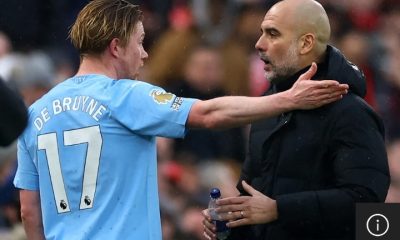
 Manchester City10 months ago
Manchester City10 months agoReport: Manchester City attacking midfielder De Bruyne ‘desperate’ to join English football giants
-

 Manchester City12 months ago
Manchester City12 months agoCongratulations: Erling Haaland become a father as side chick delivered baby boy earlier today by BBC..
-
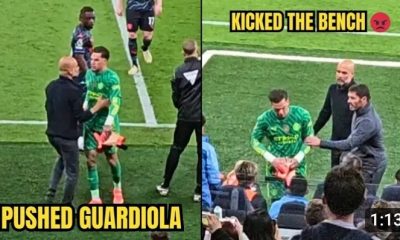
 Manchester City10 months ago
Manchester City10 months agoFootage of Ederson’s Angry Reaction to Pep Guardiola made Phil Foden to send him a warning massage,Pep was shocked when he saw what Phil wrote.
-
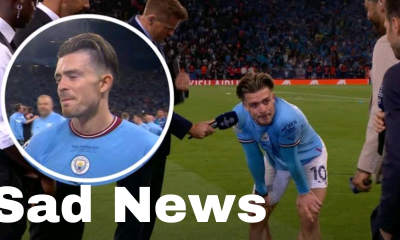
 Manchester City9 months ago
Manchester City9 months ago“Everyone at Man City wants me out, even the fans want me out
-

 Uncategorized8 months ago
Uncategorized8 months agoSky Sport Confirmed Tottenham has signed Manchester City best player€66m rated,Ange Postecoglou smile
-
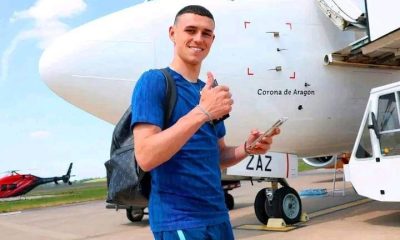
 Manchester City10 months ago
Manchester City10 months agoCongratulations to Phil Foden as he bought a new private jet.

